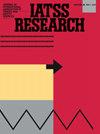Critical conflict probability: A novel risk measure for quantifying intensity of crash risk at unsignalized intersections
IF 3.3
Q3 TRANSPORTATION
引用次数: 0
Abstract
A significant number of traffic crashes are reported at unsignalized intersections. However, in developing countries, challenges such as underreporting and limited crash data hinder the direct correlation of traffic conflicts with reported crashes for effective safety analysis. To address this, the study introduces Critical Conflict Probability (CCP) as a novel metric to quantify the intensity of conflict risk at unsignalized intersections. Higher CCP values indicate a greater likelihood of crash risk. CCP is derived from Post-Encroachment Time (PET) using the Generalized Extreme Value (GEV)-based extreme value theory (EVT) modeling framework. The CCP values are modeled as a function of traffic flow and driving behavior variables using three approaches: fixed parameters, random intercept, and grouped random parameters Beta regression models. The results revealed grouped random parameters Beta regression model as the best fit, highlighting the importance of accounting for spatial unobserved heterogeneity. As a practical outcome, the study develops a CCP-based intersection prioritization framework to rank and identify critical intersections within a traffic network, enabling traffic planners to improve safety management in data-scarce environments.
临界冲突概率:一种量化无信号交叉口碰撞风险强度的新风险测度
据报道,大量的交通事故发生在没有信号的十字路口。然而,在发展中国家,诸如少报和有限的碰撞数据等挑战阻碍了将交通冲突与报告的碰撞直接联系起来进行有效的安全分析。为了解决这一问题,本研究引入临界冲突概率(CCP)作为一种新的度量来量化无信号交叉口的冲突风险强度。CCP值越高,表明崩溃风险的可能性越大。CCP是利用基于广义极值(GEV)的极值理论(EVT)建模框架,从入侵后时间(PET)推导出来的。CCP值被建模为交通流量和驾驶行为变量的函数,使用三种方法:固定参数、随机截距和分组随机参数Beta回归模型。结果显示,分组随机参数Beta回归模型最适合,突出了考虑空间不可观测异质性的重要性。作为一项实际成果,该研究开发了一个基于ccp的十字路口优先排序框架,用于对交通网络中的关键十字路口进行排序和识别,使交通规划者能够在数据稀缺的环境中改进安全管理。
本文章由计算机程序翻译,如有差异,请以英文原文为准。
求助全文
约1分钟内获得全文
求助全文
来源期刊

IATSS Research
TRANSPORTATION-
CiteScore
6.40
自引率
6.20%
发文量
44
审稿时长
42 weeks
期刊介绍:
First published in 1977 as an international journal sponsored by the International Association of Traffic and Safety Sciences, IATSS Research has contributed to the dissemination of interdisciplinary wisdom on ideal mobility, particularly in Asia. IATSS Research is an international refereed journal providing a platform for the exchange of scientific findings on transportation and safety across a wide range of academic fields, with particular emphasis on the links between scientific findings and practice in society and cultural contexts. IATSS Research welcomes submission of original research articles and reviews that satisfy the following conditions: 1.Relevant to transportation and safety, and the multiple impacts of transportation systems on security, human health, and the environment. 2.Contains important policy and practical implications based on scientific evidence in the applicable academic field. In addition to welcoming general submissions, IATSS Research occasionally plans and publishes special feature sections and special issues composed of invited articles addressing specific topics.
 求助内容:
求助内容: 应助结果提醒方式:
应助结果提醒方式:


